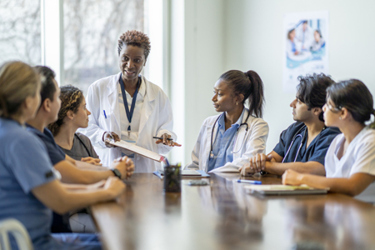Extended GCP Training Is A "Must" For Cell And Gene Therapy Clinical Trials
By Jessica Cordes, Clinical Excellence GmbH

Cell and gene therapies (CGTs) carry specific challenges and risks in clinical trials for patients, investigators, and sponsors. So, all involved parties need proper training to ensure patient safety, data quality, and Good Clinical Practice (GCP) and regulatory compliance, especially regarding the guidelines for CGT therapies. GCP applies to the design, planning, conduct, monitoring, recording, auditing, analysis, and reporting of clinical trials and ensures that the data and reported results are reliable and truthful and that the rights, integrity, and privacy of patients are safeguarded.
GCP Training Basics
GCP training should cover the following basic principles:
- roles and responsibilities of the clinical trial team
- ethical and legal aspects of clinical research
- protocol
- informed consent process
- documentation and record-keeping
- adverse event reporting
- quality assurance and auditing
- relevant national and international guidelines and regulations.
Additional GCP Training Specific To Cell & Gene Therapy Clinical Trials
In addition to general GCP training, clinical trials with CGTs may require extended training, including but not limited to:
- product characteristics (e.g., a living cell product)
- manufacturing and handling procedures (i.e., genetic modification, variable yield of transduced cells)
- collection and processing of biological samples (i.e., special requirements around genetically modified organisms)
- administration and follow-up of the CGT (i.e., controlled thawing in the case of cryogenic products)
- management of potential complications and side effects (e.g., cytokine release syndrome)
- long-term monitoring of outcomes and safety (e.g., persistence of the modified gene)
- clinical trial-specific functional plans.
Different clinical trial teams, such as site and apheresis unit staff, service providers like labs and couriers, and sponsors, should get training that suits their needs and skills. Training CGT clinical trial teams is challenging because of the complicated and new products and procedures that they need to know and do well. Also, these teams may have limited resources and time, which makes it harder for them to get trained. So, the sponsor needs to think about the separate ways of providing training and how they work better or worse for different people and situations.
GCP Training Formats
When it comes to learning something new, certain formats may be more appealing to or appropriate for certain people and/or roles. Here are a few training formats to consider:
- Manuals and protocols: These are written instructions that explain how to do certain activities or processes related to the clinical trial in detail (examples: drug handling manual, lab manual). They are good for consistency and finding things, but they may not be enough to ensure people understand and remember complicated information. They also require learners with sufficient reading and writing skills and may not be of interest to some learners.
- Videos and webinars: These materials use sound and images to show or teach how to do certain tasks or procedures for the clinical trial (examples: informed consent process). They are helpful for visual and auditory learners (especially patients), and they can improve the comprehension and recall of complicated information. They also enable communication and feedback from the trainers and other participants. However, they may require high-speed internet and technical devices to access, and they may not be convenient for those living in different time zones or accommodate all learning speeds.
- E-learning modules: These are online courses that teach different aspects of the clinical trial (for example, data capture instructions and sample collections) in an interactive and self-paced way. They can suit different learning styles and preferences, and they can give quick feedback and evaluation of learning results. They also let learners choose when and where to access them. However, they may require high digital literacy and motivation from the learners, and they may lack human support and guidance from their trainers or peers.
- Workshops and simulations: These sessions are in-person or online and teach learners how to do specific tasks or procedures for the clinical trial (examples: drug preparation and administration). They help improve practical skills and confidence, and they can create realistic and immersive scenarios that mimic the real-life situations that may happen during the clinical trial. They also let trainers and other participants watch and give feedback. However, they may require a lot of resources and coordination to set up and run, and they may not be suitable for some learners because of location or logistics.
Suggestions For Developing A GCP Training Strategy
Certain formats may better suit teams with limited resources and time, depending on the kind and degree of training they need, the features and preferences of the learners, and the access to and standard of the training materials and resources. However, some broad suggestions are:
- Mix different formats to match different learning goals and results. For example, use manuals and protocols for simple and consistent information, use videos and webinars for complicated and changing information, use e-learning modules for personal and self-paced learning, and use workshops and simulations for cooperative and practical learning.
- Adopt a flexible and adaptable approach that enables the training content and delivery to be tailored and adjusted to different learners and settings. For example, use brief and clear modules that focus on specific topics or skills (i.e., inclusion/exclusion criteria), use different degrees of challenge and complexity that fit the learners' background and expertise (i.e., apheresis collection), and use different methods and mediums of delivery that meet the learners' needs and convenience.
- Monitor and evaluate the training’s impact and effectiveness continuously and iteratively. For example, measure the learners' knowledge and skills with pre- and post-tests, collect the learners' feedback and satisfaction with surveys and interviews, and use follow-up and reinforcement activities to help the learners retain and apply the training. Involve learners from all involved parties (e.g., sites, service providers, and sponsors) in this approach.
To enhance the parties’ comprehension of the highly complicated CGT clinical trials, the training methods that offer detailed and thorough descriptions and illustrations of the products and procedures involved, as well as chances for practice and feedback in authentic and applicable scenarios, are the most effective. Hence, some of the optimal methods are:
- visual aids, animations, diagrams, and examples that illustrate how the products are made, kept, moved, and used, as well as how the procedures are done, watched, and assessed, in videos and webinars
- online courses that teach the science, rules, ethics, and risks of the products and processes, using engaging tests, games, situations, and examples
- practical activities and scenarios that allow the learners to practice the skills and processes involved in the products and procedures, with actual or simulated materials, equipment, and data, as well as acting out roles, solving problems, and discussing outcomes.
Before the clinical trial begins, sponsors should hold a longer investigator meeting to review all essential aspects of CGT and consider possible situations that may occur during the trial. Workshops can be done at this time. Training on known risks and their likelihood, effect, and detectability, and the planned risk reduction steps is very important. Everyone involved should know why the clinical trial is designed the way it is, what risks it involves, and how to check if the risk reduction steps work.
Communication and escalation lines should be practiced as well. For CGT trials, it is essential to keep track of the clinical trial progress and stay in touch with all parties involved. Because these trials have a higher risk level, any problems should be reported to the sponsor quickly.
The sponsor should also make sure that the training is refreshed whenever there are new developments in the protocol, the product, the rules, or the scientific knowledge.
Certification Of GCP Training
An important part of training is to evaluate how well it works. This means ensuring that the trainees have learned the essential knowledge and skills to do their roles in the clinical trial. An effectiveness check can use different methods, such as quizzes, tests, case studies, simulations, observations, or feedback surveys. At the end of the training session, or soon after, the effectiveness check should be done and the outcomes should be recorded and kept.
The effectiveness check should also be done again at regular intervals (e.g., every two years for GCP) to make sure that the trainees keep and refresh their knowledge and skills during the clinical trial.
A crucial part of training is the certification of the trainees. A training certificate is a document that verifies that a person has finished a training course and passed an effectiveness check successfully. A training certificate should contain the following information:
- the name (and if on-site, the signature) of the trainee
- the name and signature of the trainer
- the name and logo of the training provider
- the title and description of the training course
- the date and duration of the training
- the learning objectives and outcomes of the training
- the training format.
A certificate of attendance is a document that shows that a person has joined a training course, but it does not mean that they have learned or grasped the content. A certificate of attendance is not enough to prove compliance with GCP and other regulations and should be followed by an effectiveness check and a certificate.
High-Quality Training Is A Must For Cell & Gene Clinical Trials
Cell and gene therapy clinical trials are innovative and complex interventions that require high-quality training for the investigators and staff involved. The training should cover the scientific principles, ethical issues, regulatory requirements, and practical aspects of CGT products and procedures. The training should also be tailored to the specific protocol, risks, and outcomes of each clinical trial. To ensure compliance and effectiveness, the training should be documented by certificates that indicate the completion of the course and the assessment of the learning objectives. Certificates of attendance are not sufficient to demonstrate competence and should be followed by an effectiveness check and a certificate.
About The Expert:
 Jessica Cordes started her clinical operations career in 2009, working at various companies including Big Pharma and several small to midsize biotech companies. She gained extensive experience on different levels from country study management, global study management, and, since 2018, leadership in clinical operations. During her time at Medigene and Immatics, she structured the clinical operations department, built cohesive global teams, and implemented GCP and ATMP-compliant processes. For more than 12 years, she has been working in oncology clinical trials (including hemato-oncology as well as solid tumors) and with ATMPs since 2018. Since 2023, she has been working as an independent consultant and trainer, supporting small companies in building their clinical operations group and setting up their clinical trials for success. She is providing a GCP refresher course via her Clinical Excellence Training Academy.
Jessica Cordes started her clinical operations career in 2009, working at various companies including Big Pharma and several small to midsize biotech companies. She gained extensive experience on different levels from country study management, global study management, and, since 2018, leadership in clinical operations. During her time at Medigene and Immatics, she structured the clinical operations department, built cohesive global teams, and implemented GCP and ATMP-compliant processes. For more than 12 years, she has been working in oncology clinical trials (including hemato-oncology as well as solid tumors) and with ATMPs since 2018. Since 2023, she has been working as an independent consultant and trainer, supporting small companies in building their clinical operations group and setting up their clinical trials for success. She is providing a GCP refresher course via her Clinical Excellence Training Academy.
